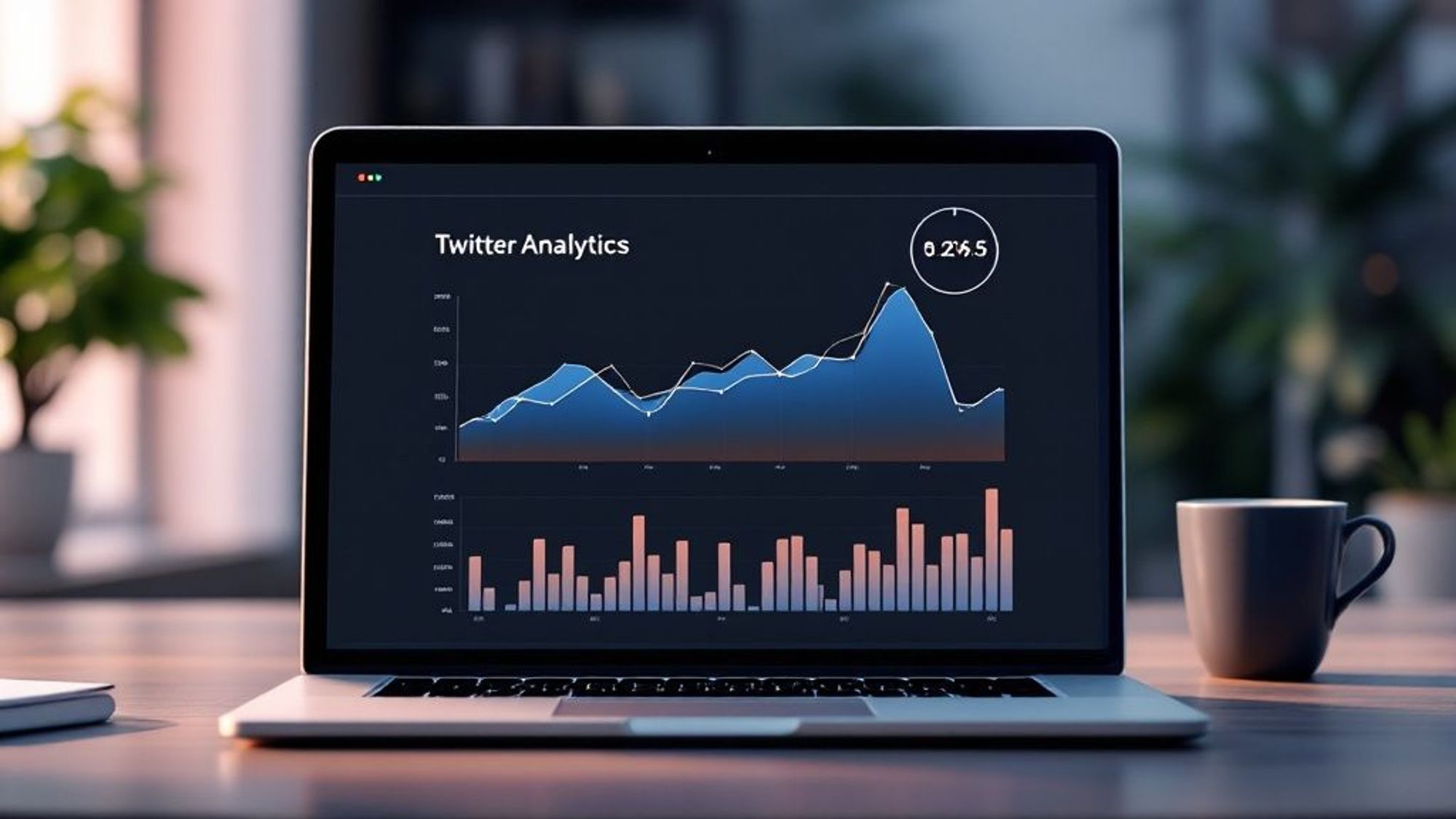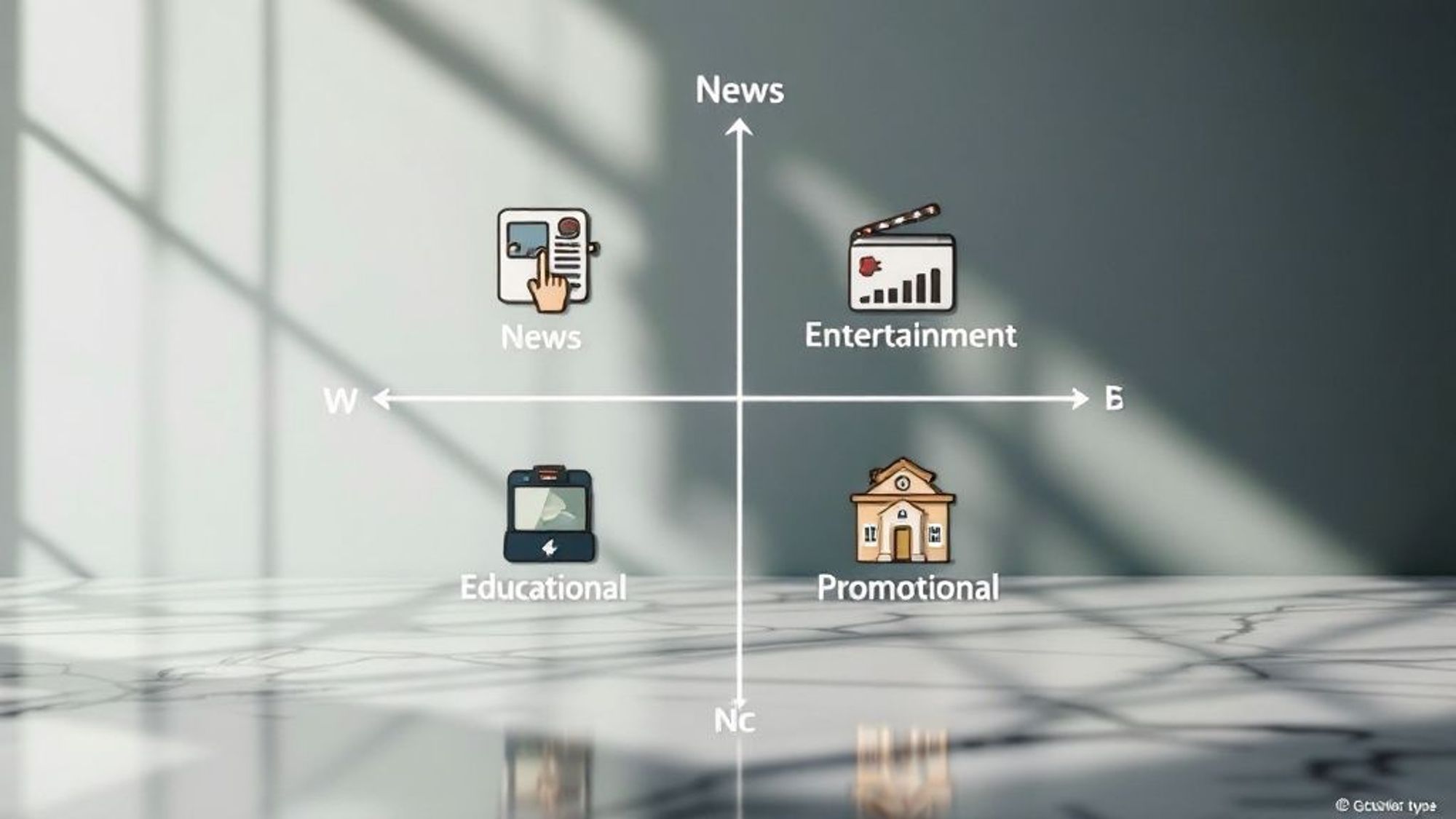Thursday, May 15, 2025
6 Winning Strategies: Optimal Time to Tweet in 2025
Tweet Smarter, Not Harder: Mastering the When of Twitter
Want to maximize your Twitter impact? Knowing the optimal time to tweet is crucial for reach and engagement. This listicle provides six powerful strategies to pinpoint the perfect tweeting windows for your specific audience and content. Learn data-driven platform-specific timing, industry best practices, time zone optimization, content-type timing, counter-programming, and event-based timing strategies. Stop wasting time and start seeing results by optimizing your tweet timing.
1. Data-Driven Platform-Specific Timing
Finding the optimal time to tweet isn't about following generic advice; it's about understanding your audience. Data-driven platform-specific timing focuses on leveraging platform analytics and third-party research to pinpoint when your followers are most active and engaged. This approach ditches the one-size-fits-all mentality and customizes posting schedules to match your unique audience demographics and behavior patterns. Instead of relying on assumptions, this strategy grounds your tweeting schedule in concrete data, leading to more effective social media campaigns.

This method uses tools like Twitter Analytics and various third-party social media management platforms to collect crucial data on your audience's engagement patterns. By focusing on audience-specific engagement metrics such as likes, retweets, replies, click-throughs, and even conversions, you can create highly customized posting schedules. Furthermore, incorporating A/B testing into your strategy allows you to continuously refine your timing and adapt to any shifts in audience behavior. Learn more about Data-Driven Platform-Specific Timing Strategically scheduling your tweets is crucial for maximizing their impact. For a deeper dive into effective scheduling techniques, check out this guide on how to schedule social media posts.
The benefits of a data-driven approach are clear. It's highly personalized to your specific audience, meaning your tweets are more likely to be seen and engaged with. It's based on actual data rather than assumptions, leading to more informed decision-making. And, importantly, it adapts to changing audience behaviors over time, ensuring your strategy remains effective. For example, HubSpot analyzed 20,000 tweets and found their B2B audience engaged most between 8-10am on weekdays, leading them to adjust their posting schedule accordingly. Similarly, Wendy's social media team uses engagement heatmaps to time their viral tweets for maximum reach, and The New York Times schedules breaking news tweets based on hourly engagement patterns. These examples illustrate the power of understanding the optimal time to tweet for specific audiences.
However, this approach does require consistent analysis and adjustment. It may also necessitate premium tools for more comprehensive insights, and the initial data collection period might delay implementation. Some technical knowledge is also needed to properly interpret the data.
To get started, begin with a 2-4 week data collection period to establish a baseline. Track metrics beyond just likes and retweets – consider click-throughs, conversions, and other relevant KPIs. Test at least three different posting times before drawing conclusions, and re-evaluate your optimal times quarterly, or even more frequently, as audience behaviors can shift. This method, popularized by research teams at HubSpot, Buffer, and Hootsuite, offers the most precise way to pinpoint the optimal time to tweet for your unique audience, ultimately leading to higher engagement rates and better results.
2. Industry-Specific Timing Strategy
Finding the optimal time to tweet isn't one-size-fits-all. The industry-specific timing strategy recognizes that peak engagement times vary significantly across different business sectors. This approach focuses on tailoring your tweeting schedule to align with the online behavior of your target audience within your specific industry. By understanding when your audience is most active and receptive on Twitter, you can maximize the visibility and impact of your content. This method works by analyzing industry trends, audience behaviors, and even competitor activity to pinpoint the most effective posting windows.

This strategy categorizes optimal posting times by industry vertical, considering both B2B and B2C nuances. It also accounts for industry-specific events and cycles, such as conferences or product launches, and integrates competitive timing analysis to identify opportunities and avoid the echo chamber effect. For example, healthcare brands often see higher engagement during lunch hours when medical professionals are taking breaks. B2B tech companies, on the other hand, might find Tuesday and Thursday mornings optimal for product announcements targeting business decision-makers. Fashion retailers frequently experience higher engagement during evening commute hours and Sunday nights when consumers are browsing online.
This method deserves its place on the "optimal time to tweet" list because it provides a more targeted and nuanced approach than generic recommendations. By accounting for the unique behavioral patterns of your specific industry's audience, you can significantly improve your chances of reaching them when they're most likely to engage. This can translate into increased visibility, website traffic, and ultimately, conversions. Learn more about Industry-Specific Timing Strategy for B2B contexts.
Pros:
- More targeted than general timing recommendations: Focuses on your specific audience's behavior.
- Accounts for unique industry audience behaviors: Recognizes that different industries have different peak activity times.
- Can provide a competitive advantage when properly implemented: Allows you to reach your audience when competitors might be less active.
- Often aligns with customer decision-making cycles: Increases the chances of influencing purchasing decisions.
Cons:
- Industry benchmarks may not reflect yourspecificaudience: Requires further refinement and testing.
- Requires regular industry research to maintain relevance: Audience behavior can shift over time.
- May create an echo-chamber effect if everyone in the industry posts simultaneously: Important to differentiate your posting schedule strategically.
- Less effective for brands spanning multiple industries: Requires a more complex, multi-layered approach.
Tips for Implementing an Industry-Specific Timing Strategy:
- Research your top 3-5 competitors' posting patterns: Use social listening tools to identify their most successful posting times.
- Create an industry-specific heat map of engagement times: Visualize peak engagement periods for your industry.
- Consider seasonal variations specific to your industry: Account for holidays, events, and other cyclical factors.
- Test posting shortlybeforeindustry peak times to gain a first-mover advantage: Capture attention before the influx of content.
This approach has been popularized by industry leaders like Sprout Social's Industry Benchmark Reports, TrackMaven's Industry Analysis Team, and Adobe Digital Index researchers, solidifying its importance in the social media marketing landscape. By diligently researching and implementing an industry-specific timing strategy, you can optimize your tweet scheduling for maximum impact and gain a valuable edge over your competitors.
3. Time Zone Optimization
Finding the optimal time to tweet isn't just about when you post, but where your audience is located. Time Zone Optimization tackles this challenge by strategically scheduling your tweets to align with the peak activity periods of your audience across different geographic locations. Instead of limiting your reach by posting solely based on your local time, this approach ensures your content is seen by a global audience when they are most likely to engage. This method is crucial for maximizing the potential of your Twitter strategy and finding the truly optimal time to tweet.

Time Zone Optimization involves mapping your audience across global time zones and then implementing a staggered posting schedule. This often includes recycling high-performing content, tailoring it slightly for different regions if necessary. By leveraging scheduling tools like those highlighted on the Learn more about Time Zone Optimization page, you can automate this global timing strategy, ensuring consistent delivery across multiple time zones. Features of a successful time zone optimization strategy include mapping audiences across global time zones, implementing staggered posting schedules, using content recycling for key time zones, and incorporating scheduling tools to automate global timing.
For example, NASA expertly uses this strategy, timing major announcement tweets to reach audiences across all time zones, generating global excitement and engagement. Similarly, Airbnb posts the same content at different times, targeting European, North American, and Asian peak hours, respectively. Netflix also utilizes this strategy, staggering new release announcements to align with prime-time evening hours in major markets worldwide. These brands demonstrate the power of strategic time zone management for optimal tweet timing.
Pros:
- Extends organic reach to global audiences.
- Maximizes engagement across geographic regions.
- Particularly effective for brands with international followings.
- Can increase total engagement by 20-35% compared to single time zone posting.
Cons:
- More complex to implement and maintain.
- May require a larger content calendar and more creation resources.
- Risk of over-posting if not carefully managed.
- Analytics become more complicated across multiple time zones.
Tips for Implementation:
- Identify your top 3 geographic regions by follower count: Focus your initial efforts on where the majority of your audience resides.
- Use Twitter Analytics to confirm time zone activity patterns: Data-driven insights are essential for pinpointing peak engagement times.
- Schedule variations of the same content for different time zones to avoid duplication: Slight tweaks can keep your content fresh and relevant.
- Consider creating region-specific accounts for very large international brands: This allows for highly targeted messaging and community building.
This approach, popularized by research from Buffer and Hootsuite, as well as Neil Patel's cross-time zone strategy, is highly recommended for brands targeting international audiences. While it requires more effort than simply posting during your local peak hours, the potential for significantly increased reach and engagement makes Time Zone Optimization a valuable component of any successful Twitter strategy for finding the optimal time to tweet.
4. Content-Type Timing Optimization
Finding the optimal time to tweet isn't just about hitting the right hour; it's about aligning your content with your audience's mindset. Content-Type Timing Optimization recognizes that different types of content resonate better at different times. By strategically matching your content (news, entertainment, educational, promotional) to specific posting windows, you can significantly improve engagement without simply increasing your posting frequency. This approach deserves a spot on this list because it moves beyond generic time slots and dives into the nuances of audience behavior and content relevance.

This method involves categorizing your content based on its purpose and then mapping each category to ideal time windows. For example, educational content might perform well on Tuesday mornings when professionals are seeking industry insights, while entertaining content might be better suited for Friday afternoons as people anticipate the weekend. This strategy requires understanding your audience's mindset at different times and days. Are they actively seeking information during their commute, or are they looking for lighthearted distractions in the evening? By answering these questions, you can create content-specific posting schedules tailored for optimal engagement.
Features of Content-Type Timing Optimization include:
- Categorizing content by type and purpose: Defining clear categories for your content (e.g., news, how-to guides, product promotions) is crucial for effective scheduling.
- Mapping each content type to optimal time windows: Research and testing are essential to identify the best times for each category.
- Considering audience mindset at different times/days: Understanding your audience's needs and behaviors at different times is key to maximizing relevance.
- Creating content-specific posting schedules: Developing dedicated schedules for different content types ensures consistent and effective delivery.
Pros:
- Increases relevance by matching content to audience context: Delivering the right content at the right time maximizes its impact.
- Improves engagement rates without increasing posting volume: Quality over quantity – achieve better results with strategic timing.
- Helps organize and structure content calendar: Categorization simplifies content planning and scheduling.
- Provides framework for content creation priorities: Aligning content creation with optimal posting times streamlines workflow.
Cons:
- Requires extensive content categorization: Initial setup requires thoughtful categorization of content types.
- More complex scheduling system needed: Managing multiple content-specific schedules requires a more sophisticated approach.
- May limit spontaneous or trending content opportunities: Strict adherence to schedules may hinder real-time engagement.
- Needs regular testing to validate content-time relationships: Audience behavior can change, so ongoing testing is necessary to maintain optimal performance.
Successful implementations of this strategy can be seen in various brands. LinkedIn, for example, often posts educational content on Tuesday mornings when professionals are looking for industry insights. BuzzFeed, on the other hand, tends to share entertaining content on Friday afternoons as their audience seeks weekend distractions. The Morning Brew might tweet breaking business news early in the morning but save more in-depth analysis pieces for evening commute times.
Tips for Implementation:
- Create a content matrix matching content types to timeframes. Learn more about Content-Type Timing Optimization and leverage content calendar generators to assist you.
- Test promotional content across different dayparts to identify conversion sweet spots.
- Schedule informational content during business/working hours.
- Reserve entertainment and inspirational content for evenings and weekends.
This approach is particularly beneficial for digital marketing professionals, social media strategists, content creators, brand managers, and social media managers seeking to optimize their Twitter presence. Understanding when your audience is most receptive to different types of content is crucial for maximizing your reach and engagement. Frameworks like CoSchedule's Content Type Research, Jay Baer's content timing framework, and Social Media Examiner's content categorization system offer excellent starting points for implementing Content-Type Timing Optimization and ultimately finding the optimal time to tweet.
5. Counter-Programming Strategy
Finding the optimal time to tweet often involves chasing peak posting times, leading to a crowded, noisy feed. But what if you zigged when everyone else zagged? That's the essence of the Counter-Programming Strategy. This unconventional approach deliberately avoids peak posting times, opting instead for less competitive "off-peak" hours when audience attention is less divided. By tweeting when fewer brands are vying for eyeballs, your content can paradoxically achieve higher visibility and engagement due to reduced competition in followers’ feeds. This makes it a valuable strategy to consider when determining the optimal time to tweet.
This strategy relies on identifying and targeting engagement windows with lower competition. It requires mapping the typical “noise level” of Twitter timelines and using an almost algorithmic understanding to find visibility opportunities. Essentially, you're employing pattern interruption to stand out from the constant stream of content.
Why does this deserve a spot on the list of optimal times to tweet? Because sometimes, the best time to tweet isn't when everyone is tweeting. For accounts with smaller followings, especially, cutting through the noise is crucial. Counter-programming offers a viable path to reaching your target audience without being drowned out by larger, more established accounts.
Features and Benefits:
- Identifies low-competition windows: Focuses on periods when fewer brands are actively tweeting.
- Maps timeline noise: Analyzes typical Twitter activity to pinpoint quieter periods.
- Leverages algorithmic understanding: Exploits the dynamics of the Twitter algorithm to maximize visibility.
- Employs pattern interruption: Stands out by posting when others aren't.
Pros:
- Reduced competition: Your tweets face less competition in followers’ feeds.
- Higher visibility: Increased chance of your content being seen.
- Better engagement rates: While absolute engagement numbers might be lower due to a smaller audience, rates (engagement relative to reach) can be significantly higher.
- Advantage for smaller accounts: Offers a level playing field for accounts struggling to gain traction.
Cons:
- Smaller potential audience: Fewer people are actively using Twitter during off-peak hours.
- Missed conversation opportunities: May miss out on trending topics and real-time engagement.
- Requires testing: Identifying the right off-peak windows for your audience requires experimentation.
- Limited real-time engagement: Less opportunity for immediate interaction and conversation.
Examples of Success:
- Wendy's: Found that late evening (10pm-midnight) tweets often received higher engagement rates despite a smaller audience.
- Denny's: Built their quirky brand voice and gained a significant following by dominating late-night Twitter conversations.
- B2B Companies: Some B2B companies have found success tweeting on weekend mornings to reach executives during their downtime.
Actionable Tips for Implementing Counter-Programming:
- Map competitor activity: Analyze your competitors' posting schedules to identify gaps and opportunities.
- Test off-peak windows: Experiment with posting 1-2 hours before or after traditional peak times.
- Consider early mornings: Explore very early morning (5-6am) when competition is low but early risers are active.
- Enhance visuals and hooks: Use higher contrast visuals and stronger hooks to grab attention during off-peak times.
Popularized By:
- Rand Fishkin: Known for advocating a contrarian marketing approach.
- Denny's Social Media Team: Masters of late-night Twitter engagement.
- Gary Vaynerchuk: Promotes pattern disruption as a key element of successful social media strategy.
By strategically leveraging the quieter moments on Twitter, the Counter-Programming Strategy can be a highly effective way to optimize your posting schedule and improve your overall social media performance. It’s not about avoiding the optimal time to tweet entirely, but rather recognizing that "optimal" can sometimes mean finding the times when your specific audience is most receptive, even if that's outside the typical peak hours.
6. Event-Based Timing Strategy
Finding the optimal time to tweet can often be less about the clock and more about the calendar. The Event-Based Timing Strategy focuses on aligning your tweeting schedule with specific events to capitalize on heightened audience attention and engagement. This can include both planned events, like holidays, product launches, industry conferences, sports games, or TV premieres, and unplanned events, such as breaking news or trending topics. This strategy requires agility and constant monitoring but can dramatically amplify reach and engagement when executed effectively, making it a crucial consideration when determining the optimal time to tweet.
How it Works:
This strategy revolves around identifying events relevant to your target audience and then crafting content that resonates within the context of that event. For planned events, this involves creating a content calendar well in advance, developing engaging posts, and scheduling them strategically. For unplanned events, the focus shifts to rapid response, leveraging real-time monitoring tools to identify trending topics and quickly crafting relevant content.
Features of an Effective Event-Based Strategy:
- Event Mapping: Map annual, seasonal, and one-time events relevant to your target audience.
- Quick-Response Protocols: Establish clear protocols for reacting to unexpected trends and breaking news.
- Pre-Planned Content: Develop engaging content in advance for anticipated events.
- Real-Time Monitoring: Utilize social listening and trending topic tools.
Pros:
- Capitalizes on Existing Attention: Taps into existing audience conversations and interest around the event.
- Potential for Viral Reach: Aligning with trending topics can significantly boost visibility and reach.
- Higher Engagement Rates: Event-related content often generates higher than average engagement.
- Natural Content Calendar Anchors: Events provide natural anchors for your content calendar.
Cons:
- Requires Rapid Response: Unplanned events demand quick thinking and content creation.
- Risk of Appearing Opportunistic: Inauthentic or forced connections to events can damage brand perception.
- High Competition: Major events attract high volumes of content, increasing competition.
- Continuous Monitoring Required: Staying on top of trends requires ongoing monitoring and analysis.
Examples of Successful Implementation:
- Oreo's "You can still dunk in the dark" tweet during the 2013 Super Bowl blackout: This real-time marketing masterstroke perfectly capitalized on an unexpected event, generating massive buzz and solidifying Oreo's reputation for social media savvy.
- Brands tweeting during major award shows like the Oscars or Grammys: Live-tweeting during these events allows brands to engage with viewers in real-time and join the ongoing conversation.
- Companies timing product announcements to coincide with industry conferences: This generates targeted buzz and media attention within a relevant audience.
Tips for Implementing an Event-Based Strategy:
- Create an Annual Event Calendar: Plan ahead by mapping out relevant events for the entire year.
- Establish Brand Alignment Guidelines: Determine which trending topics align with your brand values and messaging.
- Prepare Response Templates: Develop templates for rapid response to unexpected events.
- Post Strategically: Consider posting slightly before event peaks to establish an early presence and capture initial interest. Find the optimal time to tweet within the event timeframe.
Popularized By:
- Oreo's Super Bowl social team: Their real-time marketing success set a new standard for event-based tweeting.
- Twitter's own Moments feature: This feature curates tweets around specific events, highlighting the power of event-based content.
- David Meerman Scott's real-time marketing concept: His work emphasizes the importance of agility and responsiveness in the digital age.
This Event-Based Timing Strategy deserves its place on this list because it offers a powerful way to connect with your audience in a relevant and timely manner. By understanding how to leverage both planned and unplanned events, you can significantly enhance your social media reach, engagement, and overall impact, truly optimizing the time you choose to tweet.
Optimal Tweet Timing Strategies Comparison
Take Control of Your Tweet Timing with Schedul
Finding the optimal time to tweet is crucial for maximizing your reach and engagement on Twitter. From leveraging platform-specific data insights and understanding industry trends to optimizing for different time zones and content types, mastering tweet timing is a multifaceted endeavor. This article has explored six key strategies—data-driven platform-specific timing, industry-specific timing, time zone optimization, content-type timing optimization, counter-programming, and event-based timing—that can significantly amplify your Twitter impact. By understanding and implementing these strategies, you’re not just throwing tweets into the void; you’re strategically placing your message in front of the right audience at the right moment. This translates to increased visibility, higher engagement rates, and ultimately, a stronger presence on Twitter.
The key takeaway? Don't just tweet – tweet smart. The optimal time to tweet isn't static; it's a dynamic variable you can control and optimize for continuous improvement. By embracing these strategies, you gain a competitive edge, ensuring your tweets resonate with your target audience and drive meaningful results for your brand or business.
Ready to transform your Twitter strategy and discover the true power of optimal tweet timing? Schedul empowers you to implement these strategies effortlessly. From scheduling across multiple time zones to analyzing performance data, Schedul streamlines the process of optimizing your tweet timing for maximum impact. Start your free trial with Schedul today and unlock the potential of your Twitter content: Schedul
No credit card required!